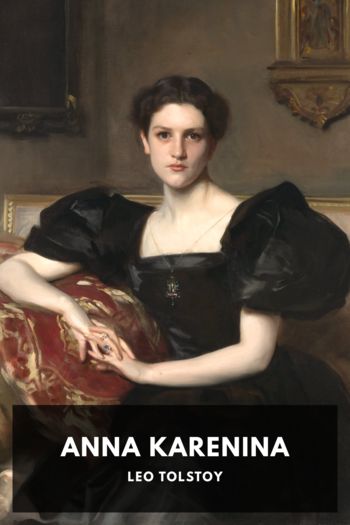What Is Art? Leo Tolstoy (good books to read for 12 year olds TXT) 📖

- Author: Leo Tolstoy
Book online «What Is Art? Leo Tolstoy (good books to read for 12 year olds TXT) 📖». Author Leo Tolstoy
“Es Folgt nun ein Fünfblatt von Künsten, die der subjectiven Sinnlichkeit entkeimen” (There results then a pentafoliate of arts, growing out of the subjective perceptions), says Kralik (p. 175). “Sie sind die ästhetische Behandlung der fünf Sinne.” (They are the aesthetic treatment of the five senses.)
These five arts are the following:—
Die Kunst des Geschmacksinns—The art of the sense of taste (p. 175).
Die Kunst des Geruchsinns—The art of the sense of smell (p. 177).
Die Kunst des Tastsinns—The art of the sense of touch (p. 180).
Die Kunst des Gehörsinns—The art of the sense of hearing (p. 182).
Die Kunst des Gesichtsinns—The art of the sense of sight (p. 184).
Of the first of these—die Kunst des Geschmacksinns—he says: “Man hält zwar gewöhnlich nur zwei oder höchstens drei Sinne für würdig, den Stoff künstlerischer Behandlung abzugeben, aber ich glaube nur mit bedingtem Recht. Ich will kein allzugrosses Gewicht darauf legen, dass der gemeine Sprachgebrauch manch andere Künste, wie zum Beispiel die Kochkunst kennt.”4
And further: “Und es ist doch gewiss eine ästhetische Leistung, wenn es der Kochkunst gelingt aus einem thierischen Kadaver einen Gegenstand des Geschmacks in jedem Sinne zu machen. Der Grundsatz der Kunst des Geschmacksinns (die weiter ist als die sogenannte Kochkunst) ist also dieser: Es soll alles Geniessbare als Sinnbild einer Idee behandelt werden und in jedesmaligem Einklang zur auszudrückenden Idee.”5
This author, like Renan, acknowledges a Kostümkunst (Art of Costume) (p. 200), etc.
Such is also the opinion of the French writer, Guyau, who is highly esteemed by some authors of our day. In his book, Les problèmes de l’esthétique contemporaine, he speaks seriously of touch, taste, and smell as giving, or being capable of giving, aesthetic impressions: “Si la couleur manque au toucher, il nous fournit en revanche une notion que l’œil seul ne peut nous donner, et qui a une valeur esthétique considérable, celle du doux, du soyeux du poli. Ce qui caractérise la beauté du velours, c’est sa douceur au toucher non moins que son brillant. Dans l’idée que nous nous faisons de la beauté d’une femme, le velouté de sa peau entre comme élément essentiel.”
“Chacun de nous probablement avec un peu d’attention se rappellera des jouissances du goût, qui out été de véritables jouissances esthétiques.”6 And he recounts how a glass of milk drunk by him in the mountains gave him aesthetic enjoyment.
So it turns out that the conception of art as consisting in making beauty manifest is not at all so simple as it seemed, especially now, when in this conception of beauty are included our sensations of touch and taste and smell, as they are by the latest aesthetic writers.
But the ordinary man either does not know, or does not wish to know, all this, and is firmly convinced that all questions about art may be simply and clearly solved by acknowledging beauty to be the subject-matter of art. To him it seems clear and comprehensible that art consists in manifesting beauty, and that a reference to beauty will serve to explain all questions about art.
But what is this beauty which forms the subject-matter of art? How is it defined? What is it?
As is always the case, the more cloudy and confused the conception conveyed by a word, with the more aplomb and self-assurance do people use that word, pretending that what is understood by it is so simple and clear that it is not worth while even to discuss what it actually means.
This is how matters of orthodox religion are usually dealt with, and this is how people now deal with the conception of beauty. It is taken for granted that what is meant by the word beauty is known and understood by everyone. And yet not only is this not known, but, after whole mountains of books have been written on the subject by the most learned and profound thinkers during one hundred and fifty years (ever since Baumgarten founded aesthetics in the year 1750), the question, What is beauty? remains to this day quite unsolved, and in each new work on aesthetics it is answered in a new way. One of the last books I read on aesthetics is a not ill-written booklet by Julius Mithalter, called Rätsel des Schönen (The Enigma of the Beautiful). And that title precisely expresses the position of the question, What is beauty? After thousands of learned men have discussed it during one hundred and fifty years, the meaning of the word beauty remains an enigma still. The Germans answer the question in their manner, though in a hundred different ways. The physiologist-aestheticians, especially the Englishmen: Herbert Spencer, Grant Allen and





Comments (0)